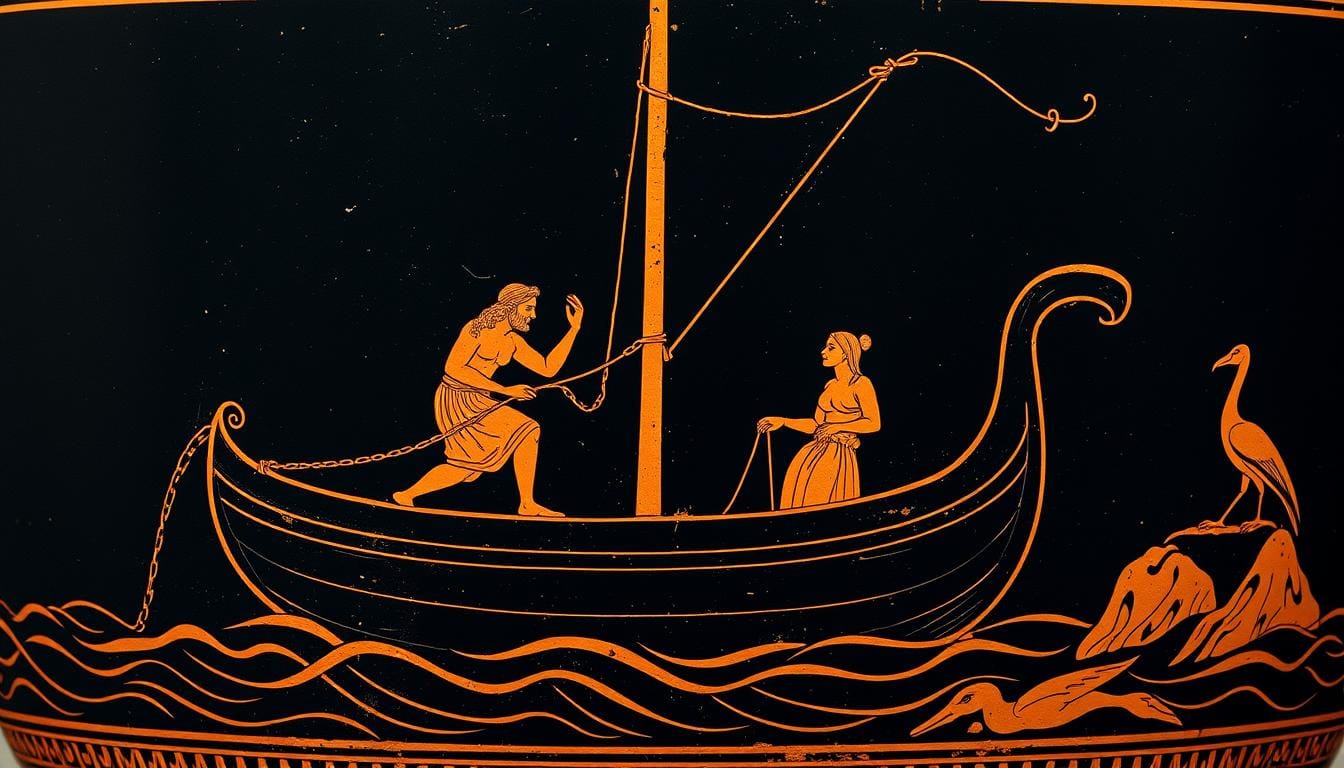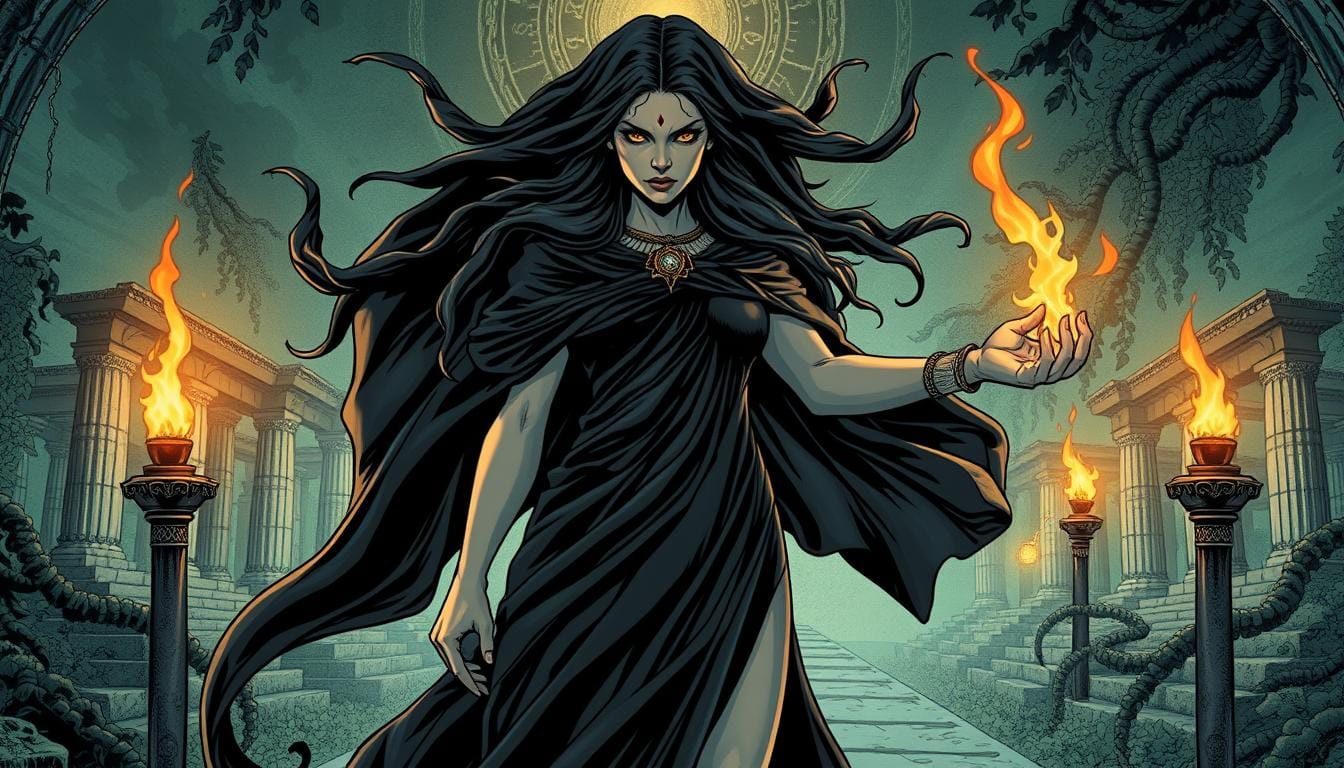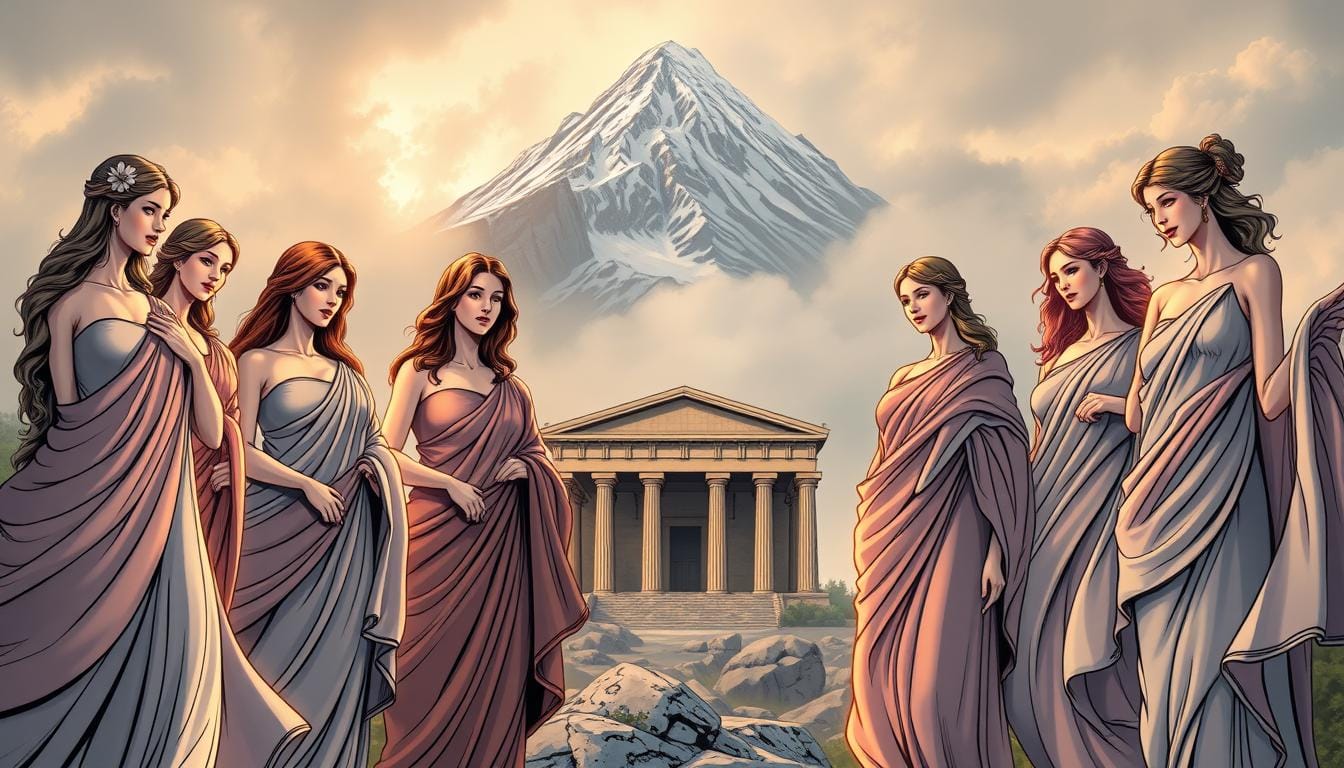Did you know that over 2,500 years after her stories were first told, this ancient Greek mythological goddess is a top search in classical mythology? Her story draws in millions, linking life and death in ways we find fascinating today.
This goddess is a symbol of a powerful paradox. She rules the dark underworld and brings back the light of spring. Her story shows the eternal battle between darkness and light in our world.
From being Demeter’s beloved daughter to the queen of Hades, her journey is one of change and strength. This guide covers all of her mythology. It shows how her legend shapes modern culture and inspires people all over the world.
Key Takeaways
- Persephone serves as both ruler of the underworld and herald of seasonal renewal
- Her myth explains the ancient Greek understanding of seasonal cycles and agricultural patterns
- The goddess represents transformation, resilience, and the balance between opposing forces
- Her story bridges themes of death and rebirth that remain relevant in modern culture
- She evolved from Demeter’s cherished daughter into a powerful divine sovereign
- Her legend continues to inspire literature, art, and spiritual practices worldwide
Introduction to Persephone: A Dual Goddess
In the rich tapestry of Greek mythology, Persephone stands out. She is unique among the gods and goddesses. Unlike others, she represents two opposing forces.
Her story has touched people for centuries. It speaks to anyone who has gone through big changes. Persephone is both the queen of the dead and the bringer of spring.
The Mythical Origins of Persephone
Persephone’s birth is described in different ways, but her divine parents are agreed upon. Demeter, the goddess of harvest and agriculture, is her mother. Zeus, the king of the gods, is her father in most stories.
She was first known as Kore, meaning “maiden” in ancient Greek. This name shows her innocence before her big change. She spent her youth surrounded by flowers and meadows, symbolizing spring’s joy.
Demeter loved her daughter more than anything. This love would play a key role in Greek mythology’s most powerful story.
The Symbolism of Duality in Her Character
Persephone’s story shows the deepest dualities in human life. Her journey from maiden to queen shows growth through hard times. It mirrors the natural world’s cycles of life and death.
The table below shows her dual nature:
| Light Aspect | Dark Aspect | Symbolic Meaning |
|---|---|---|
| Spring Goddess | Queen of Underworld | Seasonal renewal and death |
| Innocent Maiden | Wise Ruler | Growth through experience |
| Life Bringer | Death’s Companion | Natural life cycles |
| Joy and Celebration | Sorrow and Loss | Emotional complexity |
Her duality goes beyond simple opposites. Persephone shows the wisdom gained from experiencing both joy and sorrow. She understands life’s full range in a way others don’t.
This makes her story very relevant today. The myth of Persephone talks about personal power, change, and finding strength in tough times. Her journey from a sheltered youth to a powerful goddess speaks to anyone facing life’s changes.
Persephone's Role in Greek Mythology
Persephone’s story is a key part of Greek mythology. It shows how she changed the world of gods and humans. Her life and relationships tell us about change, power, and staying strong.
Her journey shows the cycle of life and the need for change. This is how the ancient Greeks saw the world.
Daughter of Demeter
As Demeter’s daughter, Persephone was the symbol of spring and growth. Her mother, Demeter, loved her very much. Persephone brought hope and new life to the earth.
She spent her days picking flowers, making the earth fertile. People and gods loved her for this.
Her bond with her mother kept nature in balance. Demeter’s daughter was key to the earth’s fertility.

The Abduction by Hades
Persephone’s life changed when Hades, god of the underworld, took her. This made her Hades’ wife. It changed the world.
Hades fell in love with her beauty. He took her to the underworld, causing trouble for all.
Demeter’s sadness made the earth barren. Crops failed, and people starved. The gods knew they had to act.
Zeus made a deal. Persephone would spend time with her mother and time with Hades. This created the seasons we know today.
| Aspect of Abduction | Immediate Consequence | Long-term Impact | Mythological Significance |
|---|---|---|---|
| Hades’ Love | Persephone’s Disappearance | Seasonal Cycle Creation | Explains Natural Phenomena |
| Demeter’s Grief | Earth’s Barrenness | Agricultural Calendar | Divine Emotion’s Power |
| Zeus’ Intervention | Negotiated Compromise | Cosmic Balance | Divine Justice System |
| Persephone’s Transformation | Dual Identity | Queen of Underworld | Personal Growth Theme |
Lessons from Persephone's Journey
Persephone’s story teaches us about adapting and finding strength in hard times. She grew from a young girl to a powerful queen. This shows how we can grow through challenges.
Her story also talks about consent and being in control. She started as a captive but became a queen. This shows we can find power even when things are tough.
Her life shows the importance of balance. She had two roles, in the underworld and on earth. This balance made her strong.
Her myth also teaches about the cycle of life. Spring comes after winter, and hard times come before good ones. Persephone’s return to earth brings hope.
Her relationships with Demeter and Hades show the complexity of love. She loved her mother and had a strong bond with her husband. This shows we can love many people deeply.
The Underworld: Persephone's Realm
Beneath the earth, Persephone rules as queen of the underworld. This place, known as Hades, was more than just a punishment zone. It became a kingdom of justice, renewal, and change, thanks to Persephone.
Her life in both worlds helped people understand life’s biggest mysteries. The ancient Greeks saw her story as key to death and rebirth.
Description of the Underworld
The underworld in ancient Greek religion had many areas for souls. The entrance was by the river Styx, where Charon took souls across. Beyond, it divided into places that showed the moral sides of humans.
Elysium was for heroes and the good, with eternal peace. The Asphodel Meadows were for those who lived average lives. Tartarus was for the worst offenders, a place of punishment and thought.
At the heart was Persephone’s palace, with gardens of strange and beautiful flowers. These plants grew in eternal twilight, showing life can grow in darkness.
The palace’s design was both beautiful and serious. It had precious metals and gems, and rivers of memory and forgetfulness. It was a place of deep change, not horror.
Persephone's Power and Influence
As queen, Persephone had extraordinary authority over the dead. She brought justice and mercy, unlike the harshness often linked with death. She guided souls through their transition.
Her power also affected the seasons on earth. When she went to the underworld, the earth mourned. Plants withered, and the world grew quiet.
Her return in spring brought life back. Flowers bloomed, and crops grew. This cycle was vital for farmers.
Persephone could give second chances and spiritual growth. Souls could learn from their past and move forward. She showed that endings can lead to new beginnings.
The seasonal cycles she controlled were more than just for farming. They were spiritual lessons. They taught that death is not the end but a part of life’s cycle of change.
The Spring Equinox and Rebirth
When Persephone comes back from the underworld, she brings renewal and agricultural abundance. Her journey is key to understanding seasonal changes in ancient Greece. The spring equinox is more than a date; it’s a spiritual awakening that touches daily life.
Ancient communities planned their year around this divine cycle. Farmers looked for Persephone’s return before starting their work. The earth’s change from winter to spring shows her journey from death to life.

Sacred Festivals and Divine Homecoming
The Eleusinian Mysteries were the most sacred celebration of Persephone’s return. These secret rites drew pilgrims from all over. Participants went through a deep spiritual change, reliving Persephone’s journey.
Spring festivals combined religious devotion with practical preparation. Sacred processions went through fields and villages, blessing the land. Priests and priestesses carried symbols of renewal like fresh flowers and young grain.
These festivals did more than celebrate. They strengthened community bonds and marked the shift from winter’s scarcity to spring’s abundance. Families shared the first fruits, thanking Persephone for renewed life.
Seasonal Rhythms and Farming Wisdom
Persephone’s myth and agricultural symbolism guided ancient farmers. Her story explained why certain crops grew in specific seasons. Wheat and barley, sacred to Demeter, were planted when Persephone ascended.
Greek farmers worked with the divine timeline, knowing that going against it was risky. Timing was everything in ancient farming, and Persephone’s myth was the perfect guide.
| Season | Persephone’s Position | Agricultural Activity | Symbolic Meaning |
|---|---|---|---|
| Spring | Ascending to Earth | Planting and Sowing | Renewal and Hope |
| Summer | With Demeter | Growth and Cultivation | Abundance and Life |
| Autumn | Preparing for Descent | Harvest and Storage | Gratitude and Preparation |
| Winter | In the Underworld | Rest and Planning | Death and Reflection |
This mythological calendar shaped many aspects of life, from weddings to business. People believed that major life events should align with Persephone’s journey for success. Her story offered spiritual meaning and practical wisdom for life’s challenges.
The genius of Persephone’s myth is turning seasonal changes into a personal story. Ancient Greeks didn’t just see spring’s arrival; they celebrated a beloved goddess returning home.
Persephone and Demeter: The Mother-Daughter Bond
The bond between Demeter and Persephone goes beyond just family. It’s a key part of ancient Greek stories. It shows the deep connection between humans and nature.
When Hades took Persephone, he hurt more than just a family. He affected all life on Earth.
Demeter, the goddess of harvest, was devastated. Without her daughter, the earth suffered. This shows how personal pain can affect everyone.
The Effects of Persephone's Absence
Persephone’s disappearance was a disaster. Demeter’s sadness made the earth barren. Crops withered, and seeds wouldn’t grow.
Demeter stopped caring for the earth. She wore mourning clothes and searched for her daughter. Without her, plants and animals faced famine.
Mortals were caught in the middle of this divine drama. They needed a solution to survive. This myth shows how gods’ feelings affect us.
Demeter's Grief and Its Consequences
Demeter’s grief turned her destructive. She ignored the comfort of other gods. Her sadness was overwhelming.
The earth’s first winter began. Without Persephone, nothing grew. Animals and humans suffered greatly.
Zeus had to step in. He knew Demeter’s grief was a threat. The crisis needed a divine solution.
| Aspect of Demeter’s Grief | Immediate Effect | Long-term Consequence | Resolution Required |
|---|---|---|---|
| Abandonment of duties | Crop failure | Potential extinction | Divine intervention |
| Endless searching | Neglect of mortals | Human suffering | Information about Persephone |
| Refusal of comfort | Isolation from gods | Cosmic imbalance | Daughter’s return |
| Transformation of nature | Environmental devastation | Seasonal cycles | Compromise agreement |
Eventually, a deal was made. Persephone would spend time with her mother and be queen. This myth explains why seasons change and the pain of growing up.
Their story teaches us about the importance of letting go. Demeter learned to accept her daughter’s new life. This balance brought peace to both the divine and natural worlds.
The Transformation of Persephone
Persephone’s journey from a young maiden to a powerful queen is a deep mythological tale. This mythological goddess changed in ways that reshaped her identity and world view. Her story shows how tough times can make us stronger and wiser.
From Maiden to Queen
Before her abduction, Persephone was Kore, a happy young woman. She loved spending time in flowers and meadows. Her life was simple, filled with joy and her mother’s love.
The underworld changed her life. At first, she was scared and resistant. But she soon learned to rule over the dead with wisdom.

Her change wasn’t just about accepting her new life. Persephone became a compassionate yet firm ruler. She earned respect from the souls she ruled.
The pomegranate seeds she ate were more than a deal. They showed her choice to be queen, not just a victim.
Embracing Dual Roles: Life and Death
Persephone’s greatest achievement is balancing life and death. As a mythological goddess, she connects these two worlds. This makes her special among ancient deities.
In the underworld, she rules with kindness and wisdom. She knows suffering because she has felt it. Her empathy comes from her own journey through loss.
When she returns to earth, she brings life and energy. Her presence ends winter and awakens new life. She brings underworld wisdom to the living.
Her dual life taught her that strength comes from struggle. She learned to accept both joy and sorrow. This shows that adversity can empower us, not defeat us.
Today, people find inspiration in Persephone’s story. It shows us that we can grow through hard times. Her journey tells us that we can find strength in our darkest moments and come out transformed.
Cultural Impact of Persephone
Persephone’s myth has inspired many, from ancient Greek pottery to today’s novels. Her story has become a symbol that touches hearts across cultures and time. The myth of Persephone is a treasure trove of inspiration for artists and writers.
Her tale of transformation, loss, renewal, and feminine power speaks to us all. This is why her story remains a cornerstone in art. Each new generation finds fresh meaning in her ancient tale.
In Literature and Art
Persephone’s legacy began in ancient Greece with stunning sculptures and pottery. Artists showed her abduction with great drama, capturing her change from maiden to queen. These works highlighted the emotional depth of her transformation.
In the Renaissance, artists saw the myth of Persephone as a chance to explore beauty, tragedy, and divine intervention. Gian Lorenzo Bernini’s sculptures brought her story to life. The baroque period introduced more dynamic views, showing her complex character.
Victorian literature loved Persephone’s dual nature, drawing parallels with human emotions. Poets like Alfred Lord Tennyson and Dante Gabriel Rossetti saw her journey as a mirror to our own. Their works celebrated feminine agency and transformation, reflecting concerns about women’s roles.
The Romantic movement saw her as a symbol of nature’s cycles and change. Writers used her myth to ponder life, death, and rebirth. This period laid the groundwork for many modern interpretations.
| Historical Period | Artistic Medium | Key Themes Emphasised | Notable Examples |
|---|---|---|---|
| Ancient Greece | Pottery and Sculpture | Divine transformation, seasonal cycles | Red-figure vases, marble reliefs |
| Renaissance | Painting and Sculpture | Beauty, tragedy, divine intervention | Bernini’s “Rape of Proserpina” |
| Victorian Era | Poetry and Literature | Feminine agency, emotional cycles | Tennyson’s “Demeter and Persephone” |
| Modern Period | Novels and Theatre | Psychological complexity, empowerment | Contemporary retellings and adaptations |
Modern Interpretations of Her Myth
Today, artists and writers focus on Persephone’s agency, not just her victimhood. Modern stories show her making her own choices. This change reflects growing respect for feminine power and freedom.
Feminist literature sees her journey as a path to self-discovery and empowerment. Authors like Madeline Miller and Jennifer Saint tell her story from her own perspective. Their works dive deep into her psychological growth and relationships.
Artists continue to be inspired by her dual nature, creating pieces about change and transformation. Modern sculptures and paintings highlight her role as a bridge between worlds. Digital art and multimedia have opened up new ways to tell her story.
Theatre productions use her myth to tackle today’s issues through ancient tales. Modern adaptations deal with trauma, healing, and growth. These shows show how her story remains relevant today.
Persephone’s myth has also influenced graphic novels, video games, and interactive media. These formats offer fresh ways to tell her story, engaging audiences in new ways. Her myth keeps evolving, proving its lasting impact on culture.
Persephone in Popular Culture
Persephone’s myth has become a big hit in today’s culture. It’s not just about ancient Greek religion anymore. Her story of change, strength, and new beginnings inspires many creators. People love her because she shows both weakness and power.
Today’s storytellers see how much Persephone’s story means to us. It’s about growing up and facing new challenges. Her journey from innocence to power is something we all can relate to.
Influence on Film and Television
Hollywood loves Persephone’s story. They’ve made many films that show her as a strong character. Percy Jackson series made her popular with kids, while other films deal with deeper themes.
TV shows have also used her story in creative ways. American Gods and The Umbrella Academy have characters inspired by her. Streaming services have made shows based on Greek myths, with Persephone at the heart of them.
Animation studios also see her appeal. They’ve made animated films that bring her story to life. These films focus on nature and personal growth.
Depictions in Music and Literature
Musicians from all genres have been inspired by Persephone. Classical music and modern songs both use her story. Folk musicians love her because of her connection to the seasons.
“She is the bridge between worlds, the keeper of secrets that bloom in darkness and flourish in light.”
Young adult books have seen a surge in Persephone stories. Authors like Madeline Miller and Jennifer Saint have written bestsellers. Their books tell her story from her own perspective, focusing on her strength.
Graphic novels have also explored her story. Artists use different colours to show her two sides. These stories offer fresh takes on ancient Greek religion and mythology.
| Medium | Popular Examples | Key Themes | Target Audience |
|---|---|---|---|
| Film | Percy Jackson, Wonder Woman | Empowerment, heroism | Young adults, families |
| Television | American Gods, Lore Olympus | Modern mythology, relationships | Adults, mythology enthusiasts |
| Literature | Circe, The Song of Achilles | Female perspective, agency | Adult readers, feminists |
| Music | Hadestown, folk ballads | Seasonal cycles, love | Theatre lovers, folk fans |
Persephone’s story is more popular than ever in media. It helps us understand today’s issues while keeping us connected to the past. Her myth will continue to inspire and captivate people for years to come.
The Legacy of Persephone Today
The myth of Persephone is timeless and wise. It goes beyond ancient times to help us today. Her story of change and strength is very relevant now.
Environmental movements find inspiration in her story. Climate activists see her myth as a call to reconnect with nature. They say respecting nature’s cycles is key for our planet.
Symbol of Feminine Empowerment
Modern feminists see Persephone as a symbol of female power. Her journey from victim to queen inspires women today. She shows that adversity can empower us.
Her story challenges old views of women’s roles. Persephone takes control of her life, becoming a ruler in the underworld. She’s a powerful example of female strength.
Today, we see her as a symbol of balance. She accepts both light and darkness. Persephone teaches us to accept all parts of ourselves.
Lessons on Balance and Change
Persephone’s myth teaches us about change. Her yearly journey shows us to accept life’s shifts. Modern psychology sees this as key for growth.
Her story highlights the value of seasonal cycles for our wellbeing. Mental health experts note our disconnection from nature. Persephone’s tale encourages us to reconnect with these cycles.
She shows that balance comes from accepting opposites. Her ability to thrive in different worlds inspires us to find balance in our lives. She teaches us that each season has its purpose.
Environmental therapists use her story to promote living in tune with nature. They help clients embrace natural rhythms. Persephone’s wisdom teaches us to find harmony by accepting life’s cycles.
Her legacy inspires artists, writers, and spiritual seekers globally. They find in her story a guide for personal change. Persephone remains a symbol of renewal and strength for those seeking meaning in our changing world.
How to Celebrate Persephone's Myths
Celebrating Persephone’s myths is a great way to connect with nature and personal growth. Her story is full of rituals that celebrate seasonal changes and inner growth. These modern celebrations mix ancient wisdom with today’s life, creating authentic connections to her timeless themes.
These celebrations help us understand the deeper meanings of seasonal changes. They also bring people together through shared experiences and stories.

Seasonal Festivals and Sacred Rituals
Spring equinox celebrations welcome Persephone’s return with joyful gatherings. Many communities hold flower festivals in March and April. These include:
- Seed blessing ceremonies that honour agricultural symbolism in her myth
- Community gardens where participants plant flowers representing renewal
- Storytelling circles sharing different versions of her tale
- Seasonal feasts featuring fresh spring vegetables and fruits
Autumn harvest festivals celebrate her descent into the underworld with gratitude rituals. These events often include pomegranate sharing ceremonies, reflecting her connection to both worlds.
Personal rituals can involve meditation during seasonal transitions. Many people create home altars with seasonal flowers, fruits, and candles. These intimate celebrations help individuals connect with Persephone’s transformative energy all year.
Educational Approaches and Community Sharing
Schools can teach Persephone’s story through creative projects. Students might create artwork or write modern adaptations of her myth. These activities help young people understand agricultural symbolism and its relevance today.
Community workshops are great for sharing her story with different people. Local libraries and cultural centres often host mythology evenings. Participants explore different interpretations of her tale.
Family traditions can include seasonal storytelling sessions. Parents share Persephone’s myth with children. These moments create lasting connections between generations and keep ancient wisdom alive.
Online communities are good for sharing modern interpretations and personal experiences with her mythology. Social media groups dedicated to mythology education help spread awareness of her enduring significance in today’s culture.
Conclusion: Persephone's Lasting Influence
Persephone’s story is powerful because it shows us how to grow and be strong. She went from being a young girl to the Queen of the Underworld. Her journey teaches us about the changes we all face in life.
Reflection on Her Significance
Persephone’s story is about growing strong through tough times. She shows us that being strong means facing life’s ups and downs. Today, her story is important because it talks about being in control, new beginnings, and the cycle of life.
Her myth touches on big themes like loss, change, and starting anew. The goddess teaches us that change can make us wiser and stronger. Her return to the world brings hope and shows us that darkness will always turn to light.
The Timelessness of Mythology
Myths like Persephone’s are timeless because they talk about real human feelings. These stories connect us to the past and offer wisdom that never gets old.
Persephone’s story is lasting because it shows life’s complexity and the chance for renewal. Her tale teaches us that true strength comes from facing change with courage and wisdom.
FAQ
Who is Persephone in Greek mythology?
Persephone is a key figure in Greek mythology. She is the Queen of the Underworld and a symbol of Spring. As Demeter’s daughter and Hades’ wife, she represents both life and death.
Her role is central to understanding seasonal changes and agricultural cycles in ancient Greek beliefs.
What is the myth of Persephone’s abduction?
The myth of Persephone tells of Hades’ love for her and his abduction of her to the underworld. Her mother Demeter’s grief made the earth barren.
This story explores themes of consent, power, and transformation. It explains the origin of seasonal cycles through Persephone’s journey.
How does Persephone represent seasonal cycles?
Persephone’s journey between the underworld and earth governs agricultural life. Her return in spring brings new life and growth.
Her time in the underworld brings winter and dormancy. This myth helped ancient Greeks plan their planting and harvesting.
What is Persephone’s relationship with her mother Demeter?
Persephone and Demeter have a powerful mother-daughter bond. Demeter’s grief over Persephone’s disappearance threatened all life.
Their relationship shows the connection between humanity and nature. It highlights how maternal love affects the cosmos.
How did Persephone transform from maiden to queen?
Persephone’s journey from maiden to Queen of the Underworld is remarkable. Her experiences in Hades changed her, teaching her to navigate both light and darkness.
This transformation shows how adversity can lead to strength and wisdom.
What role does Persephone play in the underworld?
As Hades’ wife, Persephone transformed the underworld into a place of justice and renewal. She guides souls between life and death, showing her influence beyond rulership.
Her role highlights the transformative power of endings.
What were the Eleusinian Mysteries?
The Eleusinian Mysteries were sacred ceremonies in ancient Greece. They celebrated Persephone’s return from the underworld. These ceremonies promised spiritual renewal and understanding of life’s mysteries.
They were central to Greek religious practice, showing Persephone’s relevance in everyday life.
How has Persephone influenced art and literature?
Persephone’s story has deeply influenced art and literature. From ancient pottery to Renaissance paintings and modern literature, her myth has been retold. Each era has reflected its values through her story.
Modern retellings often focus on her empowerment and agency.
What does Persephone symbolise in modern culture?
In today’s society, Persephone symbolises feminine strength and empowerment. Her myth represents resilience and the ability to find power in challenges. It also highlights the importance of embracing seasonal rhythms.
How can people celebrate Persephone’s mythology today?
People celebrate Persephone through spring equinox festivals, harvest rituals, and gardening. Meditation focused on renewal and transformation also honours her. These practices connect us with natural cycles and celebrate rebirth and growth.
What lessons can we learn from Persephone’s story?
Persephone’s myth teaches us about embracing change and finding balance. It shows the transformative power of resilience. Her story teaches that endings can be beginnings, and that growth comes from facing challenges.
Why does Persephone’s story remain relevant today?
Persephone’s story remains relevant because it addresses universal human experiences. It explores loss, transformation, and renewal. Her dual nature offers a sophisticated understanding of life’s complexities, encouraging us to embrace both light and shadow.





